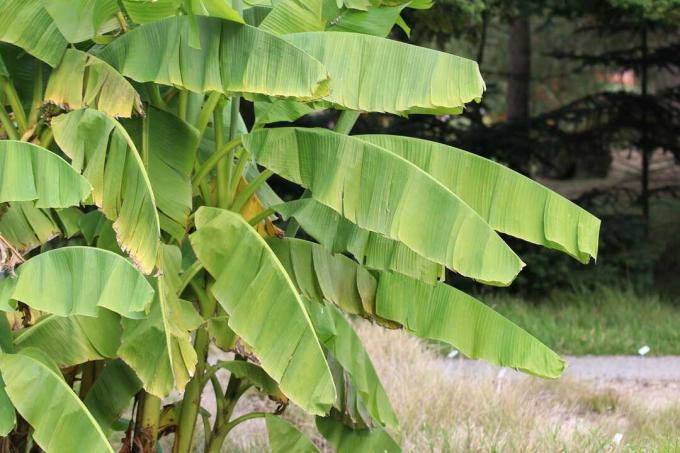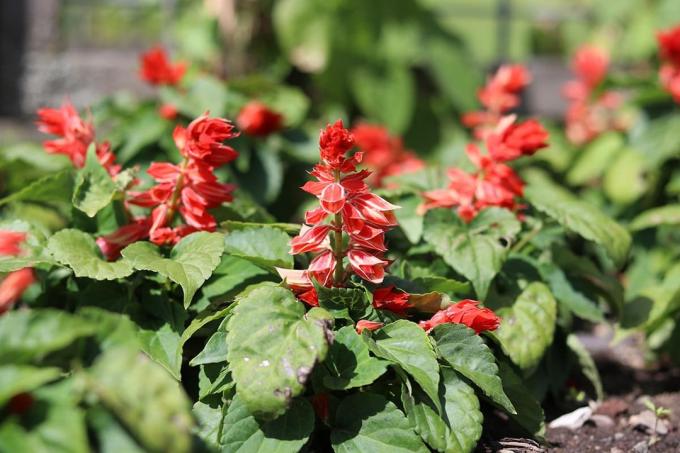

Table of contents
- Location of the banana plant
- water and nutrient requirements
- multiply
- Other Notes
Actually quite undemanding in their care, banana plants pose one or the other challenge to their owners. Even the dwarf banana - for indoor culture - easily reaches the 2 meter mark and this is the first big problem for its owners. Because the banana plant cannot be cut back like other plants that have grown a little too big. Winter brings another problem. The banana tree loves it bright and also needs enough light to thrive. So in winter that could be a problem. But here you can provide additional light with plant lights. Easy to care for, but not undemanding would be the correct terms when describing the banana plant in a few words. So here is some important information and care tips on how to take on your banana plant without going shipwreck.
Location of the banana plant
All banana species love and need sun. That's why you should place the indoor banana as close as possible to the window, but in front of it in midsummer direct sunlight – the power of the sun increases through the window – it is essential to protect it. Make sure you get some fresh air, especially in the summer. A tilted window near the site is good for the banana plant. Not only a lot of light, but also a lot of heat is expected. It should never be colder than 15 degrees Celsius in the room where the plant is located. Temperatures around 20 degrees Celsius are better. Since bananas are native to tropical Southeast Asia, high humidity is also a must. Especially in winter, due to the dry heating air, the banana plants suffer from the dry air. Therefore spray extensively several times a day. The ideal
humidity is a good 50%. In summer, ornamental bananas can also be outdoors in a sunny spot. Here, however, one should note that the thin leaves can tear in the wind.water and nutrient requirements
Large leaves form a large evaporation surface. For this reason, the banana plant needs a lot of water, especially in summer. A generous drainage layer in the pot ensures that the water is well drained from the roots. The plant tolerates waterlogging and wet feet just as little as persistent drought. Even if the plant is on a saucer or in a planter, you should never water it from below. Always from above. The nutrient requirement is moderate. The banana is one of the few plants that also want to be fertilized in winter, even if only sparingly. For optimal growth and good health, the banana plant should be given a commercial spray once a week during spring and summer liquid fertilizer obtained according to the manufacturer's instructions. Once a month in fall and winter. Due to the rapid growth, the banana has to be repotted again and again. Clay pots and good drainage should form the basic idea.
multiply
Ensete ventricosum is propagated by seeds and that is absolutely unproblematic. The best way to do this is to soak the seeds overnight. The next day, the seed can be planted in a sand-peat mixture. The pot should be covered with cling film to keep the air taut. The seed germinates best at a temperature of 25 degrees Celsius. The dwarf banana Musa acuminata is propagated through Kindel – offshoots. Over time, the plant forms new plants on the stem of the mother plant. If necessary, the children can easily be taken – preferably at the repot – remove and plant in a new pot. It is best to take offspring that have reached about 1/3 the size of the mother plant. These also now have roots that are strong enough to provide for the plant.
Other Notes
Although the banana plant is quite easy to care for, care mistakes can occur, but these are usually noticed relatively quickly. If you water too little, or if the humidity is persistently too low, the plants get brown, dry leaf edges. Here can only help if you water more and spray the plant more often. If the banana loses its leaves, this is a clear sign that it is too cold, too dark (or both). However, such plants should by no means be disposed of. Just imagine that they are lighter and warmer and they will sprout again by spring at the latest if there are no other care mistakes. Air that is too dry attracts the red spider. This must be collected and increased humidity must be ensured in the future.
 garden editorial
garden editorial I write about everything that interests me in my garden.
Learn more about perennials

20 hardy plants that bloom all year round
With plants that flower all year round, you can quickly create an attractive garden that does not require much maintenance, as long as the plants are also hardy. In this post, we will introduce you to 20 plants that are suitable for this.

17 flowering hardy plants May to October
Many plants only show their full splendor for a short time. But there are also types and varieties with a particularly long flowering period from May to October, sometimes even longer. We present 17 flowering hardy plants.

Hardy perennials: 22 perennial bloomers
Hardy perennials as permanent bloomers in the flower bed enchant the garden from early summer to autumn with a colorful bloom. They are easy to care for and magically attract butterflies, bees and the like.

10 care tips for the banana tree
If you like it exotic, cultivate a banana tree as a houseplant or in the conservatory. In summer, the banana plants are even allowed outside for a few weeks. The large leaves that the Musa forms on a false trunk are particularly decorative and impressive, and therefore look like a small tree.

Properly care for globe thistle | 10 tips for care
The globe thistle is an eye-catcher in the garden. Their spherical flowers provide a food source for insects. The globe thistle is not difficult to care for and it is suitable for dry locations. With a few tips on care, the plants will develop even better.

Fire sage, Salvia splendens: care from A to Z
Fire sage is known in botanical jargon as Salvia splendens and is a particularly decorative eye-catcher. But what kind of care does the plant need? Our guide to the salvia shows the important points from A to Z.

